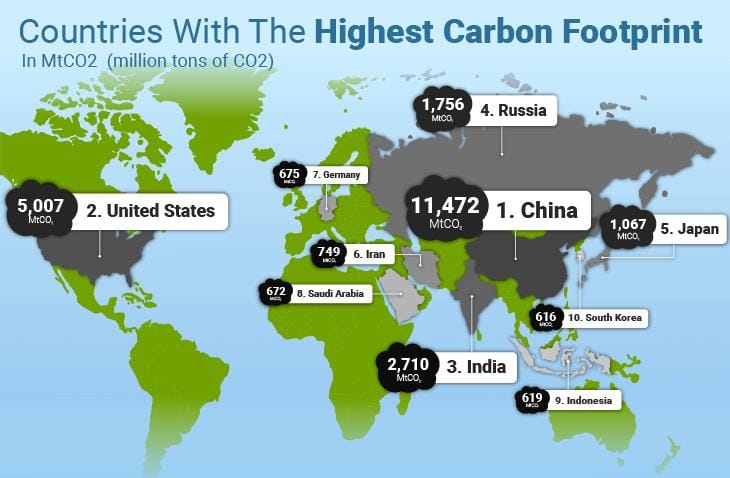These countries are the worst CO2 polluters in the world

Carbon dioxide (CO2), a seemingly harmless gas, holds a powerful grip on our planet’s climate. While essential for life, its excessive presence acts like a heat trap, causing global warming and its cascading consequences. The Industrial Revolution marked a turning point, unleashing exponential growth in manufacturing and fossil fuel reliance, paving the way for the major CO2 emitters we see today.
Dominating the Carbon Footprint:
China:
The undisputed champion of CO2 emissions, China released a staggering 11,336 million metric tons in 2021. Coal reigns supreme, fueling 58% of its energy generation. This addiction not only powers industries but also fills the air with greenhouse gas through power plants and boilers. Add to that China’s thirst for oil, powering its vast fleet of vehicles and further inflating its CO2 footprint. Despite recognizing the issue, China strives to shift its dependence towards cleaner options like nuclear, renewables, and natural gas, aiming to curb pollution in its megacities.
The United States:
Following closely behind is the US, emitting 5,032 million metric tons in 2021. Transportation, electricity generation, and industry hold the dubious honor of being the top culprits. While efforts to reduce coal reliance have been made, the US remains a major oil producer, heavily reliant on petroleum for trucks, ships, and the ever-present automobile, a symbol of American freedom that comes at a significant environmental cost. Industry, too, plays a key role, burning fossil fuels and employing chemical reactions that release CO2 into the atmosphere.
India:
The world’s third-largest emitter, India, coughed up 2,674 million metric tons in 2021. Coal remains its lifeline, providing 44% of its energy needs. While petroleum and other liquids contribute around 24%, natural gas plays a minor role (6%). Recognizing the air pollution woes, India aims to increase natural gas’s share to 15% by 2030, a crucial step towards cleaner energy sources.
Russia:
Boasting vast natural gas reserves, Russia emits 1,712 million metric tons annually. This very gas fuels its energy demands and power generation. However, coal finds its place in chemical industries and power plants, adding to the CO2 burden. As a major natural gas supplier to Europe, recent political tensions have disrupted this flow, prompting both sides to seek alternative solutions.
Japan:
Rounding out the top five is Japan, with 1,602 million metric tons in 2021. The Fukushima nuclear disaster reshaped its energy landscape, with oil now holding the reins at 38%. Coal still retains a 25% share, while nuclear power is slowly making a comeback, accounting for 23%. Aiming to reduce dependence on imported fossil fuels, Japan’s 2018 energy plan focuses on increasing nuclear-fired power production by 2030.
20 reason to go on holiday in Albania